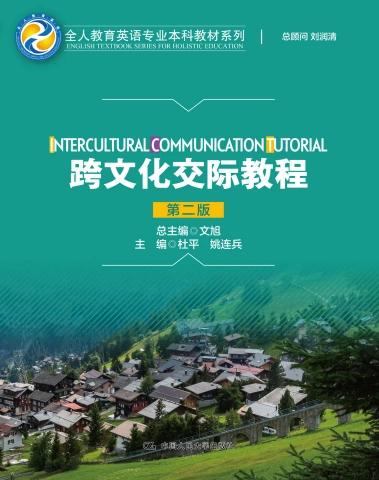INTERCULTURAL COMMUNICATIONTUTORIAL跨文化交际教程
总主编 文旭主编○杜平 姚连兵
Intercultural Communication Tutorial
跨文化交际教程
(第二版)
主编杜平 姚连兵副主编‧杨晓蓉 杨春花‧晏开维
图书在版编目(CIP)数据
跨文化交际教程:英文/杜平,姚连兵主编.--2版.--北京:中国人民大学出版社,2022.1全人教育英语专业本科教材系列/文旭总主编ISBN 978-7-300-30312-3
I. ① 跨.….ⅡI. ① 杜.…· ② 姚...ⅢI. ① 文化交流-英语-高等学校-教材IV. ① G115
中国版本图书馆CIP数据核字(2022)第021514号
全人教育英语专业本科教材系列
总顾问刘润清
总主编文旭
跨文化交际教程(第二版)
主编 杜平姚连兵
副主编 杨晓蓉杨春花晏开维
KuaWenhua Jiaoji Jiaocheng (Di-er Ban)
总序
英语专业是我国高等外语教育的重要组成部分。高等外语教育责任大、作用大、影响大、意义大,具有工具性、人文性、专业性和国际性的鲜明特点。教材承载着社会价值和文化价值,是人类智慧积累和知识传承的最重要媒介之一,是实现教育目的和功能的最重要手段之一,因而教材的研发和编写已经上升到国家事权的高度。从2014年开始,我们组织编写了这套“全人教育英语专业本科教材系列”,目的是推动我国高等外语教育、特别是英语专业教育的发展,更好地满足我国英语专业教育的多元需求。经过编写团队的艰苦努力,本套教材于2018年全部出齐,与广大师生见面,其中许多品种已经被评为省部级或者学校级优秀教材。为了适应新形势的飞速发展,迎应我国高等外语教育面临的新机遇和新挑战,锤炼精品,打造品牌,自2020年起,我们对本套教材的主干品种进行了全面修订。
一、修订依据
1.政策依据
“全人教育英语专业本科教材系列”最初编写的政策依据是《国家中长期教育改革和发展规划纲要(2010一2020年)》、《教育部关于全面提高高等教育质量的若干意见》(教高【2012】4号)以及《外国语言文学类教学质量国家标准》。本次修订,我们认真贯彻《中国教育现代化2035》《普通高等学校本科英语类专业教学指南》以及《高等学校课程思政建设指导纲要》等文件的精神,在修订过程中充分考虑到新时代我国英语专业教育的现状,并力求体现当代英语专业教育的本质特征、目标和任务,贯彻为实现目标任务所倡导的外语教育理念、教学原则、教学模式、教学过程、教学方法和教学评价,着力服务并促进我国英语专业教育改革,提升英语专业教育的内涵和质量,更好地提高英语专业学生的英语能力、跨文化交际能力和综合素质,培养全面发展的复合型人才。
2.理论依据
本套教材编写和修订的理论依据主要是教育学、心理学、语言学、认知神经科学等学科的理论和原则。其教育学依据主要是“素质教育理论”和“全人教育理论”(holisticeducation),主张“教单科、育全人,教外语、育全人”的外语教育理念;其心理学依据主要是认知心理学、社会心理学和积极心理学中相关理论,强调英语学习的特殊性,把听、说、读、写、译等基本技能与学生的多元智能有机地结合起来;其语言学依据主要是应用语言学和教育语言学,尤其是终身学习理论下的体验学习、自主学习、合作学习、泛在学习、深度学习以及适应性学习;其认知神经科学依据主要是全脑教育,认知神经科学有助于我们理解人脑的共同之处与个体差异,有助于英语教学的因材施教。人脑和智力具有可塑性,只要学生拥有信心、自尊和动机,外语学习随时都可以成功。
3.实践依据
教学实践是检验教材质量的唯一标准。在修订过程中,我们充分听取并吸收了所有使用本套教材院校的意见和建议,与一线骨干教师多次召开线上和线下座谈会、研讨会,对于修订教材的指导思想、定位、主干教材的难度和梯度(包括各册之间的有机联系等)、材料取舍、格式体例、练习设计,包括教师用书的编写,都反复推敲、打磨、完善,最后达成共识。我们力求在博采众长、适应新形势新挑战的基础上,修订出一套能够经得住时间和实践考验的优秀教材。
二、教材特色
专承初版的基础上,教材的修订进一步强化和突出以下六个
1.进一步落实立德树人根本任务
习近平总书记指出:“人才培养一定是育人和育才相统一的过程,而育人是本。人无德不立,育人的根本在于立德。这是人才培养的辩证法”(《深人学习习近平关于教育的重要论述》第49页)。立德树人是我国教育的根本任务。围绕教育的根本问题“培养什么人、怎样培养人、为谁培养人”,本套教材着力挖掘思政元素,突出中国特色社会主义和中国梦教育、社会主义核心价值观教育、法治教育、劳动教育、心理健康教育以及中华优秀传统文化教育。
2.继续贯彻“教单科、育全人,教外语、育全人”的全人教育理念
全人教育的理念是“教单科、育全人,教外语、育全人”,倡导人的“终身学习和终身发展”。这一模式体现了人本主义的基本思想:教育和学习就是要把学生培养成为有道德、有知识、有文化、有能力、和谐发展的“完人”。高等外语教育要帮助学生树立正确的世界观、人生观和价值观,教育学生认知、认同和践行社会主义核心价值观。联合国教科文组织和国际教育发展委员会编著的《学会生存一一教育世界的今天和明天》就特别强调要“培养完人”(2009:192),“把一个人在体力、智力、情绪、伦理各方面的因素综合起来,使他成为一个完善的人,这就是对教育基本目的的一个广义的界说”(2009:195)。
3.坚持围绕“教育的四大支柱”,突显体验学习、自主学习和深度学习
全人教育特别重视体验学习。本套教材的修订始终立足培养四种基本学习能力,也即教育的四大支柱:学会认知(learning toknow)、学会做事(learning to do)、学会共同生活(learning tolive together)以及学会生存(learning to be),始终把价值塑造融人语言知识、技能和学习策略中,通过任务、活动及练习引导学生进行体验学习、自主学习和深度学习。
4.加强思辨能力培养
教育的核心任务之一是培养学生的创新能力,创新能力必须以思辨能力为支撑。思辨能力培养一直是欧美高校课程设计的核心,也是全人教育的核心主张之一。本套教材在任务、活动和练习设计中,都以培养学生提出问题、分析问题、解决问题为旨归,引导学生对问题进行批判性思考,并进行有效的输出实践。比如,在修订版《英语国家概况》的练习中,我们就提供了与各章节课文内容相关的原始材料,要求学生在思考、理解的基础上,撰写适当长度学术作文(论文)。这是培养思辨能力的最有效途径之一。
5.强调英语的工具性与人文性有机结合
工具性和人文性是一切语言学习包括高等外语教育的本质特征。本套教材的修订除帮助学生掌握英语这一交流和思维工具,提高学生英语听说读写译的能力以及跨文化交际能力之外,还特别强调把以人为本、弘扬人的价值作为设计教材内容的另一核心,精心选取
具有丰富人文内涵的素材,使教材以知促行、以行促知,学以致用,并在潜移默化中培育学生的家国情怀。
分体现文明互鉴和文化交流,培养新时代国际化复合
高等外语教育的国际性体现在文明互鉴和文化交流,培养既有中国立场、家国情怀,又有国际化、全球化视野的复合型人才。基于此,本套教材选材严谨、丰富,地道、经典,融合中西文化,重视本土问题和国际问题、中西对比等问题,努力培养学生的跨文化意识,提升其跨文化能力。
三、研发团队
本套教材是专家智慧和集体智慧的结晶。顾问是我国著名外语教育专家、北京外国语大学博士生导师刘润清教授,总主编是西南大学博士生导师文旭教授。参加编写的学校主要有(排名不分先后):西南大学、北京理工大学、华中科技大学、东北大学、内蒙古大学、河南大学、贵州大学、上海海事大学、西南政法大学、山西大学、广州大学、湖南科技大学、华南师范大学、陕西师范大学、西北师范大学、四川师范大学、贵州师范大学、云南师范大学、广西师范大学、海南师范大学、西华师范大学、重庆师范大学、重庆交通大学、重庆理工大学、重庆邮电大学、浙江理工大学、沈阳工业大学、西南石油大学、新疆师范大学、青海师范大学、北京信息科技大学、长江师范学院、中国海洋大学、中国石油大学、济南大学、四川农业大学、长沙理工大学、四川文理学院、河南工业大学等。
在此,我们衷心感谢本套教材的研发团队,衷心感谢本套教材的所有使用院校,衷心感谢中国人民大学出版社外语分社对本套教材的长期大力支持。我们会继续虚心听取大家的意见和建议,使本套教材日臻完善。
全人教育英语专业本科教材系列编委会2021年3月
编写说明
一、教材编写理念
随着全球化进程的进一步加快,外语作为一个符号体系,成为各国人民相互理解的载体。学习外语的目的不仅仅在于掌握一种沟通交流的语言工具,更重要的是通过这门语言学习文化,从而更好地通过他者来认识自己的母语文化。在全球化这一背景下,我国的高等教育,尤其是外语教育发生了一系列改革和变化。经济和文化领域的全球化也对外语人才的培养提出了更高的要求,即“培养具有创新精神、跨文化交际意识、实践能力和国际竞争力的高水平人才”。关于新世纪对人才的需求,中国科学院前任院长路甬祥曾这样说过:新世纪的人才必须适应经济全球化、科技国际化的竞争与合作;新世纪人才的语言、文化、知识、视野必须全球化、国际化。在我国高等教育国际化的大趋势下,外语教学不仅需要将跨文化这一理念融人教学中,还应从传统的知识传授型课堂教学模式转变成以“全人教育”为中心的教育模式,正如西南大学文旭教授所言,“教单科(外语),育全人”。
传统外语教学偏重实用知识的传授,教师扮演的角色是传道授业解惑,授学生以鱼。在这种视外语为交流工具的教学理念主导下,传统外语教学侧重于培养有着扎实语言功底和专业知识的技能型人才。因此,外语专业的学生普遍缺乏创造性和批判性思维能力,即“思辨缺席症”。在“全人教育”思想指导下,外语教学至少应做到以下几点:一是外语教学应侧重培养有道德、有知识、有能力、和谐发展的“完人”;二是外语教学在传递知识和培养技能的同时,还应关注学生内在情感和人格的全面培养;三是外语教学在强调自我实现的同时,还应强调真诚的人际交往和跨文化的人类理解;四是外语教学应该注重学生人文精神的培养,使学生开阔视野,树立正确的价值观,学会批判性思维和终身学习。
针对近年来英语专业教育面临的新问题和新挑战,以及目前市面上教材存在的诸多不足,中国人民大学出版社邀请文旭教授作为总主编,以“全人教育”理念为指导,编写旨在培养学生技能和综合能力、注重人文素质和文化意识熏陶、强调全面发展的英语专业教材。《跨文化交际教程》作为该系列教程之一,秉承“全人教育”的理念,从跨文化这一视角出发,通过对比中西核心文化层面的不同,旨在培养学生的跨文化意识和多元视角,以及在提高跨文化交际能力的同时,通过教材中的案例分析、阅读理解等实践环节培养学生的思辨能力。本教材在选材时强调“中国式”的主题,从广大学生所熟悉的和所感兴趣的方面人手,所选内容主要涉及中外文化在语言表达、日常生活、社交活动、教育领域和商务事业等方面的差异。本教材的练习和活动设计等实用环节既注重学生基本知识和听说读写译能力的“双基”培养目标,又侧重以人为本、以社会为本的“通德教育”。总的来说,本教材的编写旨在不仅能让学生学习、吸收和借鉴外国文化的精华,也让外国读者了解中国文化的精髓,从而使中外读者在不同文化的互动中提高对外族和本族文化的鉴赏力,实现真正意义上的双向跨文化教学。
二、教材编写体例
全册共分8个单元,每个单元由判断正误、谚语名言学习、两篇阅读理解、两个案例分析、两个情景训练或课堂报告、两篇短文写作和附加阅读等七个部分组成。每个单元由第一部分的判断正误引人基本的概念认识或者现象认知,这一练习题能让教师对学生的已知信息有所了解;第二部分为谚语名言学习,通过中英文的匹配,在传递单元主题信息的同时,也彰显中英文化在语言和思维、习俗等层面的异同点;第三部分的两篇阅读材料难度由浅人深,TextA引人跨文化交际领域的基本概念和理论,TextB做进一步的深人探讨,通过回答问题、翻译句子、翻译段落、单项选择等多样化练习巩固学生所学知识点;第四部分案例分析所选内容紧贴学生的学习和生活,通过提问的方式,让学生自由阐述观点,锻炼学生的分析能力和辩证思维能力;第五部分的情景训练或者课堂报告旨在训练学生运用所学知识,综合全面地展现语言能力和跨文化交际能力;第六部分的短文写作旨在拓展学生的写作思维和创新思维;第七部分的附加阅读为学生提供课后进一步自主学习的素材。总的来说,本教材每个单元以理论和实践相结合,课内和课外相结合,既有理论学习,也有案例分析,既有课堂活动设计,也能体现课外能力的培养。
本教材在编写和结构设计上以中国文化与外国文化的对比为主线,通过揭示多种文化的共性与差异,引导学生找出影响跨文化交际的文化干扰因素,从而充分认识各种不同文化背景下的思维方式与特点,培养学生的跨文化意识和交际能力,帮助他们克服交际中的语用失误和文化失误,实现成功的跨文化交际。本教材编写人员的具体分工为:第一单元(杜平),第二单元(张俊英),第三单元(杨晓蓉),第四单元、第八单元(杨春花),第五单元(季寅修),第六单元(晏开维),第七单元(郝晓东),教材配套课件(尹绍东)。在教材初稿编写出来后,美国俄亥俄州立大学的 Stephen Rolfe 博士进行了细致的校读,在此一并致谢。
本书配有电子版参考答案和教学课件,任课教师可登录中国人民大学出版社官方网站(http://www.crup.com.cn)搜索本书后下载使用,或联系huangt@crup.com.cn、wangxw@crup.com.cn、010-62512737、010-62515580索取。
由于编者水平所限,教材的不足在所难免,我们期待得到专家和读者的指正。
《跨文化交际教程》编写组2022年1月
Unit One Cultural Awareness and Intercultural Communication .
1. Warming up ·
2. Reading passages. .3
3. Group work... .·10
4. Essay writing: .·11
5. Further reading ·12
Unit Two Verbal Communication in Intercultural Communication.. ..19
1. Warming up ·19
2. Reading passages.. 20
3. Group work....
4. Essay writing.. 27
5. Further reading 28
1. Warming up 35
2. Reading passages· 36
3. Group work... 44
4. Essay writing: 45
5. Further reading 46
Unit Four Sociopragmatic Failures in Intercultural Communication. ..53
1. Warming up: 53
2. Reading passages: 54
3. Group work. 61
4. Essay writing: 63
5. Further reading 64
Unit Five Pragmatic Principles in Intercultural Communication · ......71
1. Warming up 71
2. Reading passages.. ...72
3. Group work.... 80
4. Essay writing.. ..81
5. Further reading .81
1. Warming up 87
2. Reading passages.. ...88
3. Group work... .98
4. Essay writing.. .99
5. Further reading ·100
Unit Seven Intercultural Communication under the Education Setting.... 109
1. Warming up ·109
2. Reading passages.. ..·111
3. Group work... .118
4. Essay writing... ..·120
5. Further reading .·121
Unit Eight Intercultural Communication under the Business Setting 127
Warming up ·127
2. Reading passages... ·128
3. Group work... ·137
4. Essay writing: ..·138
5. Further reading ·139
Cultural Awareness and Intercultural Communication
1. Warming up
1.1) Decide whether the following statements are true (T) or false (F)
1) Culture refers only to the high art and classical music of a particular society. (
2) Culture is learned; you can learn new attitudes and behaviors through training. (
3) In one society, people conditioned to work in casual conditions will not be shocked when placed in formal work cultures. ( )
4) Just as computers with different operating systems have difficulty communicating with each other, people from different cultures cannot communicate with each Other. ()
5) Empathy, which means trying to see the world through another's eyes, helps you be more tolerant and less judgmental. ()
1.2) Proverbs and idioms
Match the Chinese proverbs or idioms in Column A with its equivalent English in Column B.
Column A
A.封闭的心灵如同一本合上的书,不过是纸堆罢了。
B.性相近,习相远。
C.文化的价值在于它对人类品性的影响。除非文化能使品性变得高尚、有力,否则它毫无用处。文化的作用在于益人生,它的目标不是美,而是善。
D.如果你用他人听得懂的语言与之交谈,那么你的话只能说到他的脑子里;但是如果你用他人的本族语言与之交谈,那么你的话就能说到他的心坎里。
Column B
1) By nature people are nearly alike; by practice they get to be wide apart. -Confucius
2) A closed mind is like a closed book; just a block of wood.
3) If you talk to a man in a language he understands, that goes to his head. If you talk to him in his language, that goes to his heart. _Nelson Mandela
4) The value of culture is its effect on character. It avails nothing unless it ennobles and strengthens that. Its use is for life. Its aim is not beauty but goodness.
Somerset Maugham
2. Reading passages
Four Levels of Cross-Cultural Awareness
Linell Davis
Clearly something more than contact with other cultures is needed if people who do not share culture are to understand one another. In the fable of the marmosets and the reports of the French explorers, there was awareness of the other, but it was not awareness that led to understanding. Hanvey in his book An Attainable Global Perspective suggests that there are four distinct types or levels of cross-cultural awareness.
Level One: Culture differences are exotic
The marmosets in hearing about life in the city interpreted what they heard as exotic and strange. They were aware that life away from their forest home was different and undoubtedly enjoyed the entertaining stories or a bizarre and unbelievable life. This is the level of awareness that people get from watching television programs of strange and exotic ways of life. They can only see very visible cultural traits that they most often respond to with a stereotyped view of the unfamiliar culture. This is also the level of awareness of tourists who visit a foreign country on a short trip and the level of awareness most students get from their study of foreign cultures in school. At this level of contact people learn about unfamiliar holiday celebrations, colorful heroes, exotic foods and unusual costumes, music and buildings. People entertain others and themselves with tales of the strangeness of others, but what is entertaining is how unbelievablethe cultureis.
Level Two: Culture differences are frustrating
The next level of awareness comes from the more substantial contact such as the French had with the natives of North America. The French recorded volumes of information about the Indians they met, and they knew in great detail about significant and subtle cultural traits that were very different from their own way of doing things.
They found Indian life unbelievable in a most frustrating and irritating way. This is the level of awareness in which cultures are in conflict. People have knowledge of the other culture but it is still unbelievable. They find people from the other culture to be arrogant, insensitive, dirty, superstitious, manipulative, or in some other ways not very human by their standards.
LevelTbree:Tbedifferentcultureisbelievable
At the next level of awareness people also have extensive knowledge of significant and subtle cultural traits and recognize that they are different from our own traits, but now they accept the other culture and its people as fully human. The culture of the other becomes believable; it makes sense as a legitimate way of life. People can accept it in their minds. What previously seemed strange now seems less strange. People at this level are able to look beyond the surface behavior of people in the unfamiliar culture to appreciate what motivates that behavior. They respect the values that people in that culture live by. This is the level of cultural awareness that people should attain with in-depth academic study of a culture as part of a foreign language curriculum. It is also the level of awareness that trainers preparing people for work or study abroad hopetoachieve.
Level Four: The different culture is believable as lived experience
At the highest level of cross-cultural awareness a person experiences how another culture feels from the standpoint of the insider. The culture is believable because the person accepts it emotionally. He or she participates in the culture by learning the language, making friends and accepting it on its own terms. The participant experiences the culture subjectively. It becomes familiar as lived experience. This is the kind of awareness that comes from cultural immersion, from living the culture.
The goal of cross-cultural communicators is to reach Level Three or Level Four awareness. In the global village all cultures should be believable, at least intellectually, and ideally emotionally as well. To reach Level Four awareness it is necessary to go beyond objective knowledge to experience the unfamiliar culture on a feeling or emotional level. This requires imagination if you are not actually living in the culture, but you can start by reading the literature, appreciating the music and other arts of the
culture you are interested in.
Moving to higher levels of cultural awareness involves changing our emotional responses to our neighbors in the global village. To move from Level Two to Level Three people need to set their negative feelings aside to try to see the culture objectively. To move from Level Three to Level Four people need empathy, the ability to “feel with" someone who may be very different from them. One of the challenges of life in the global village is to develop more global psychology.
People often hold the naive view that contact between cultures necessarily results in greater mutual understanding. Unfortunately, the historical record does not support this belief. Achieving mutual understanding is not easy. It takes efforts, desire and patience. It helps to realize that the more people are different from one another, the more they have to learn from each other. Part of the new global psychology is appreciating how rich humanity is by appreciating what each culture contributes to it. How much poorer we would all be if we were all alike.
(862 words)
(Adapted from “Doing Culture: Cross-Cultural Communication in Action"by Linell Davis)
Word list
marmoset (南美洲产小型长尾猴)bizarre 奇异的;古怪的irritating惹人讨厌的;烦人的 arrogant 傲慢的,自大的superstitious迷信的 manipulative善于操纵的;会摆布人的legitimate合法的;正规的 in-depth 深入的,彻底的empathy 同感;共鸣;移情
2.1.1 Understanding the text
Please answer the following questions.
1) How do people at Level One usually see other cultures?
2) Can people at Level Two treat other cultures objectively? And why?
3)What attitudes may people at Level Three have toward other cultures?
4) What is the most important thing for people to attain Level Four awareness? 5) Do you think it is possible for people to achieve Level Four awareness without actually living in the culture?
2.1.2 Sentence translation
Please translate the following sentences into Chinese.
1) Clearly something more than contact with other cultures is needed if people who do notshareculturearetounderstandone another.
2) They can only see very visible cultural traits that they most often respond to with a stereotyped view of the unfamiliar culture.
3) They respect the values that people in that culture live by.
4) To reach Level Four awareness it is necessary to go beyond objective knowledge to experience the unfamiliar culture on a feeling or emotional level.
5) Part of the new global psychology is appreciating how rich humanity is by appreciating what each culture contributes to it.
2.2) Text B
Intercultural Communications—A Personal Journey
AnIntercultural Profession
To be better equipped to do that, we returned to the US in 1990. I worked on my MA in Chinese and Intercultural Communications, Anne adjusted to American culture and we started a family. When we came back in 1993, we brought 2-year-old and 3-month-old daughters with us to Shanghai. We thought it would be simpler for young children to adapt to a new culture. But the adjustments weren't easy for any of us, partly because Shanghai was just beginning its rapid modernization phase.
For the last few years we have heard almost constant construction noise around us. Our housing hadn't yet been renovated, we didn't have much heating or air conditioning, the workload was heavy at the university, the pay was low and inflation was rapid in those days. Both children were often sick with colds or more serious ailments. Yet, we somehow persevered, kept adjusting to Shanghai, tried to keep up with the fast changes, and now we have a nice apartment, our neighborhood is cleaner and more attractive and we feel more at"home".
It was my good fortune to teach in the Overseas Training Department of Shanghai International Studies University (SISU). In 1993, we started to train self-paying students for international business. I was able to develop a new course on Intercultural Communications to orient our students.
Over the years, that course has grown into a curriculum that is also being offered to the Communications Department and all post-graduate students at SIsU. This has been a rich opportunity to gather fresh data on Chinese culture as well as to develop this budding field. Relating to the China Association for Intercultural Communications (CAFIC), formed in 1995, has also been a stimulating professional experience.
An Intercultural Family
As our two girls became school age, we enrolled them in a local kindergarten. We wanted them to feel comfortable both in the language and with Chinese friends. As a result, both daughters have become trilingual, though it hasn't always been easy. Our oldest daughter, Christy, did fine in the first two years, but found it quite tough in Chinese third grade. She was almost keeping up with her Chinese classmates, but her English and German were falling behind, so she changed to the International German School in Shanghai. Our youngest daughter, Amy, is still in Chinese school. When she finishes third grade this year, she'll probably also change, though she is happy and fairly comfortable in all three contexts.
Recently Amy was working on some intercultural adjustment materials for kids. She was asked to draw a picture of her family. In the space provided, she drew a picture of me and labeled it “Dad—American" and next to Anne, “Mom-German". Then she drew a picture of our “Chinese Grandma" and labeled her “AyiChinese". When she drew herself and her sister in the middle, she paused. She then wrote “Christy and Amy—AmGerChi." When I asked about this unusual word, she said because all three cultural backgrounds were mixed in her, she used the first syllable from each nationality. In Chinese, she called herself a “MeiDeZhong." It might be difficult for her to maintain that identity, but that is how she sees herself now.
An Intercultural Future
Because this is my field of study, my wife, daughters and I hope to keep learning about cultural variety and adjustments together. We don't just want to be a crosscultural experiment; we want to relate our experiences to our Chinese friends and students. Anne works as the Consulting Doctor for the German Consulate in Shanghai and has opportunities nearly every week to cross cultural barriers with expatriates and local hospitals. Each of us hopes to become an effective “cultural bridge" to bring understanding and cooperation to the different sides we represent.
Living overseas for long periods of times is never easy. There are times when we are overcome with homesickness. Sometimes we feel lost or confused in our identity. Sometimeswefacenewlevelsofcultureshockorstress.Butwetrustthateachofthese experiences is enriching us, giving us a reservoir of feelings and insights that we can sharewithothers.
With changes due to the WTO, the coming World Cup and Olympics and developments in many other arenas, China is entering an exciting and challenging phase of internationalizing. Perhaps our intercultural journey can be of help to others.
(752 words)
(http://www.cnedu.cn/news/7-8/2011-2-23-xi21890.shtml)
Word list
inflation通货膨胀 ailment小病 budding field新兴的领域 expatriate侨民;移居国外者 reservoir蓄积;贮备
2.2.1 Reading comprehension
1) It is for young children to adapt to a new culture.
A. easy B. difficult C. fantastic D. interesting
2) At first, life was tough for the author and his family in Shanghai because
A. the couple were not well paid
B. the children were often ill C. the living condition was rather poor D. all of the above
3) How did the author's younger daughter think of her identity?
A. She preferred to be a Chinese.
B. She got confused about her identity.
C. She thought her identity was mixed in three cultures.
D. She thought it might be difficult for her to maintain her identity.
4) Living overseas for long periods of times can enrich the author because
A. he was able to overcome homesickness
B. he became clearer about his identity
C. he didn't experience any cultural shock
D. he had unique feelings and insights to be shared with others
5) Which of the following statements is TRUE?
A. The author wanted his family to be a cross-cultural experiment.
B. They have no barriers in terms of intercultural communication.
C. The author was optimistic about the family's intercultural future.
D. New levels of culture shock or stress can be beneficial to one's cultural identity.
2.2.2 Translation
Please translate the following passage into Chinese.
For the last few years we have heard almost constant construction noise around us. Our housing hadn't yet been renovated, we didn't have much heating or air conditioning, the workload was heavy at the university, the pay was low and inflation was rapid in those days. Both children were often sick with colds or more serious ailments. Yet, we somehow persevered, kept adjusting to Shanghai, tried to keep up with the fast changes, and now we have a nice apartment, our neighborhood is cleaner and more attractive and we feelmore at"home."
3. Group work
3.1 Case study
Case 1:
An American went to a Chinese home. He was offered some tea. Just when the first cup was about to finish, more tea was added. The visitor drank the second cup. Then the cup was filled the third time. Then he drank it, then...until the visitor was quite full.
Questions for discussion:
1. Why did the Chinese host keep filling tea for the guest? And why did the American guest drink all the cups of tea filled for him?
2. How do you understand the cultural differences in this case? Please list more examples to demonstrate it.
Case 2:
Jane, an American teacher in the Us, had just started teaching English to a group of Japanese students. She wanted to get to know the students more informally, so she invited them to her house for a party. The students all arrived together at exactly 8:00 \mathbf{p.m} . They seemed to enjoy the party: they danced, sang, and ate most of the food. At about 10{:}00\ p.m. , one of the students said to the teacher, “I think it's time for me to leave. Thank you very much for the party." Then all the other students got up to go, and all left at the same time. Jane decided she would never invite them again!
Questions for discussion:
1. Why did these Japanese students hurry home at 10{:}00\ {p}{.m}{.?} And why did the American teacher feel offended?
2. If you are invited to an American friend's party, what cultural differences should you beawareof?
3.2) situational act or presentation
1. Suppose you are working as a secretary in an Australian company in Melbourne. You are getting to know one of the Australian secretaries, a nice girl named Cathy, and you want to make friends with her. Try to use some specific examples to show the different ways of making friends in such an intercultural situation.
2. Suppose you are studying in America and your American friends are inviting you to stay with them over Christmas. Your friends have two little kids. One is 6 and the other is a little younger. Please talk about the gifts you want to bring with you to give to the family and work with your partners and act out the scene of the Christmas party.
4. Essay writing
Topic 1:
Now with economic globalization,the American culture continues holding its strong position and is exerting impact on every part of the world, including China. What kind of cultural awareness should we have in copying the western culture? What kind of culture awareness should we have in facing our traditional culture? Please write an essay of about 3o0 words on the following topic : The Cultural Awareness We Should Have in the Face of the Western Culture.
Topic 2:
In communication between people of different cultures, the receiver uses information from his or her culture to interpret the message. The message that the receiver interprets may be very different from what the speaker tries to convey. Communication may be hindered or even break down. Please write an essay of about 300 words on the following topic : The Problems in Intercultural Communication in Terms of Message Transmission.
5. Further reading
Text C
China's Intercultural Communication with the World in New Decade
By David Bartosch
2019 also marked the last year of the second decade of the 21st century. We are stepping into the third decade. During the past two decades, the world has undergone enormous changes, politically and economically. Since then, the world has been developing into a multipolar direction. The turn itself has been mostly imperceptible at first, but constantly increasing since the beginning, and becoming obvious during the last decade. We work together in more and more intertwined schemes. In this global sociocultural transformation, China has gained special importance. Having become the biggest producer of goods and the second-largest economic power, two-thirds of the world's fast train routes and the world's longest highways are found in China.
China and its partners are working toward world integration in a multipolar scheme. It has been rightly emphasized that we all should come together to foster winwin-strategies and intercultural communication. A growing cultural and intercultural awareness is needed. The Conference on the Dialogue of Asian Civilizations, held in May 2019 in Beijing, has been an important step in this direction. Many thousands of official cultural exchange implementation plans are signed between China and most countries worldwide each year. Last year, cities like Beijing and Berlin and many institutions developed joint programs in cultural exchange. The China Soong Ching Ling Foundation, for example, is developing great programs for children to bring Chinese and other cultural elements together. Countless Chinese people are proactively engaged in people-to-people cultural interactions all around the world.
Evolving like a collective sociocultural brain which is growing more and more interior life-lines of vivid communication, the Belt and Road is providing myriads of new possibilities and opportunities for culture-related economic developments. Beijing can be taken as an example: The restaurant scene represents the food cultures of all of China and the whole world. Countless exhibitions of works of art, traditional and modern, from all corners of the world can be visited. A great variety of top-notch international musical events have been held last year. A lot of cultural institutions from many nations are seated in Beijing.
A new form of harmonic power, as the author has coined it, is spreading its wings, dealing with the world culturally in a contemporary way which is conscious of China's and the world's heritages. The world is brought together at one table to share ideas and projects, benefits, and to develop the future conjointly. Harmonic power means gaining through sharing. This is the hallmark of a new world consciousness of humanity, emerging just here and now.
China has been one-sidedly perceived as a productive and economic power by many countries. But Chinese civilization, fluid and mutable as it is, is also among the most ancient and persistent. China's historical and cultural consciousness has evolved over many thousands of years. Modern Chinese writing goes back to the oracle bone scripts. The related artefacts are more than 3,200 years old. Currently, they are on display in the National Museum in Beijing. Isn't it amazing that these very ancient roots are still alive in the branches of the modern Chinese written language?
Many young Chinese are very interested in their ancient culture, being eager to learn and to practice it. The precious heritage has evolved in a vivid and youthful spirit, but also in combination with modern and futuristic technological developments. In this context, a growing awareness of heritage and environment is developing. China has addressed the general fields of sustainable development and environmental as well as climate protection from additional cultural and educational angles. These are all very positive developments.
In this context, the development and worldwide communication of the harmonic power of heritage-conscious modern Chinese culture will be one of the major tasks of the new decade. China's harmonic power is based on the urge for peace, exchange of cultures between civilizations, tolerance, respect and the ability to make differences complementary. We have to close the doors of an age of winner-takes-all mentalities of the preceding centuries. Myriads of beneficial win-win-possibilities lie in our hands already. We have to consciously decide what our global future should look like. It is of utmost importance to make the right decisions for a more integrated and connected
world system now.
Every person, every country and every civilization have to realize that it is in the world and how it is in the world, namely a world which is shifting and evolving at an accelerating pace. And we all—individual persons, families, communities, regions, nations and civilizations-have to reflect on how we have become what we are in constant interaction with others. It is of great importance that all civilizations nurture their cultures and start to communicate those cultural elements which are fitting and useful for others as well on the basis of larger frameworks like the Belt and Road Initiative. This will be the big task in the third decennium of the 21st century — to actively create a peaceful future for all.
(824 words)
(https://www.chinadaily.com.cn/a/202001/03/WS5e0ed7f4a310cf3e3558253a.html)
Word list
multipolar 多极的 imperceptible察觉不出的;难以察觉的
win-win-strategies 双赢策略
China Soong Ching Ling Foundation 中国宋庆龄基金会
proactively积极主动地;主动出击地 myriad 无数;大量
top-notch拔尖的;一等的 conjointly联合地
hallmark特征;标志 mutable易变的
winner-takes-all mentalities赢者通吃的心态decennium十年;十年间
Questions for consideration:
1. How does the writer look at China's harmonic power?
2. Why does the author think that China has changed the image once only perceived as aneconomicpower?
3. According to the author, what should be done for all civilizations to create a peaceful future?
The Challenge of Intercultural Communication
You are about to embark on an important and challenging venture. Important because you now live in an age when all the inhabitants of earth are interconnected. The undertaking is challenging because learning to understand people whose background is different from your own is not an easy assignment. The challenge, put in slightly different terms, is to become an effective and successful intercultural communicator as you interact with neighbors who might speak a “strange" language or a business partner who stops and prays in the middle of a meeting. For you to be successful in both these interactions, and thousands of others you will face in this new world, you must be able to communicate with those whose entire backgrounds, whose very way of viewing the world and doing things, may be completely different from yours. In short, functioning in this new world means that you understand the theories, principles, and dynamics of intercultural communication.
Intercultural communication is the circumstance in which people from diverse cultural backgrounds interact with one another. You rightly might wonder what is significant or unique about this kind of interaction. The answer is found in the sometimes extreme cultural diversity of backgrounds, experiences and assumptions resident in communicators. Cultural diversity has the potential to make intercultural communication very difficult-and in some instances utterly impossible.
The crucial element in this form of communication is culture and the impact it has on your communicative behavior. Culture strongly influences your beliefs, values, and world views; it is reflected in your use of language, your nonverbal behavior, and how you relate to others. It shapes your relationships with your family and friends; it teaches you how to raise your children, and provides you with prescriptions for forms of communication appropriate to a variety of social situations. As you can see, culture is elaborate, multidimensional, and quite pervasive; it constitutes a complete pattern of living. Various aspects of cultural influence are acted out each time members of different cultures come together to share ideas and information.
unication, as you might suspect, is not a new human en.
Since the dim beginning of civilization when the first humans formed tribal groups, intercultural contacts occurred whenever people from one tribe encountered others and discovered that they were different. Later, as civilization developed, traders, religious missionaries, and invading warriors all encountered alien people different from themselves. Alien differences have long been recognized, but in the absence of accompanying cultural knowledge, this recognition most often elicited the human propensity to respond malevolently to those differences. This reaction to aliens-to those who are physically or socially different—was well expressed over two thousand years ago by the Greek playwright Aeschylus, who wrote, “Everyone is quick to blame the alien." This penchant to blame the alien is still a powerful element in today's social and political rhetoric.
From a historical perspective, successful intercultural communication has been the exception rather than the rule. The history of humankind details an ongoing antipathy and hostility toward those who are different. The twentieth century, for instance, suffered two world wars and witnessed the introduction and use of chemical, biological, and nuclear weapons with the potential to destroy humankind. The world also endured the Holocaust and various smaller-scale conflicts such as those in Korea, Vietnam, Kuwait, Iraq, and Afghanistan. Now, the world is faced with the aftermath of the destruction of the World Trade Center in New York City and the ensuing war on terrorism. In addition, there are numerous ongoing ethnic, and tribal clashes that seem beyond resolution.
The world, people, and societies are always in a state of change. The ongoing process continually produces new set of social dynamics with which you must deal. Intercultural communication is about that change—changes in the world's fabric of social relationships that challenge us to keep pace with the changing world order. These changes at both the international and domestic levels have brought us into direct and indirect contact with people who, because of their cultural diversity, often behave in ways that we do not understand. With or without our consent, the last four decades have thrust us into social and professional situation with people who often appear alien, exotic, and perhaps even wondrous. These people may live thousands of miles away or right next door.
Our rationale for looking at these changes is threefold. First, as the familiar gives way to new and different world, the entire human race is affected. Second, many of the events that have brought diverse groups together have been too subtle to detect and have taken place over a long period. Hence, we believe many of them may have overlooked. Finally, by learning about these changes, you will learn to understand the role and impact of cultural communication and rise to meet the intercultural communication challenges posed in the twenty-first century.
(808 words)
(Adapted from“Communication Between Cultures"by Larry A.Samovar GRichard E.Porter)
Word list
embarkon着手;从事 malevolently有恶意地;恶毒地Aeschylus埃斯库罗斯(公元前525年一456年),古希腊悲剧诗人penchant偏好;嗜好 Holocaust大屠杀;浩劫wondrous令人惊叹的;神奇的 rationale根本原因;基本原理
Questions for consideration:
1. According to the passage, why is intercultural communication very difficult?
2. What does the author mean by saying “successful intercultural communication has been the exception rather than the rule"?
3. What proper attitudes should humankind take towards the intercultural communication in the changing world?





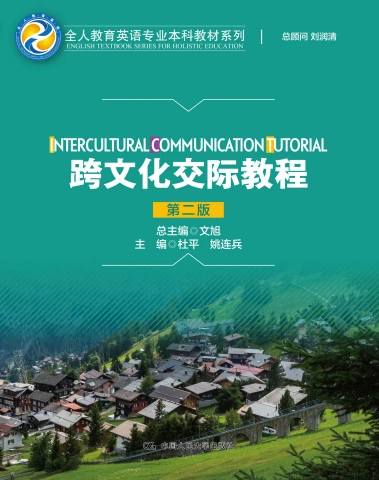

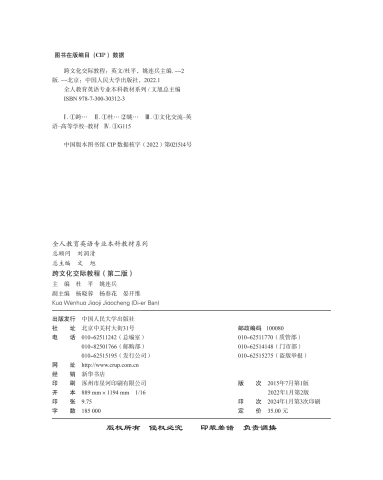

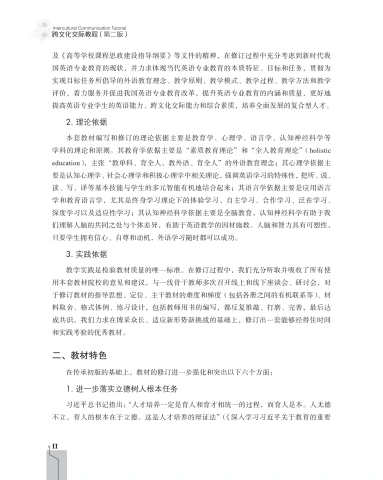

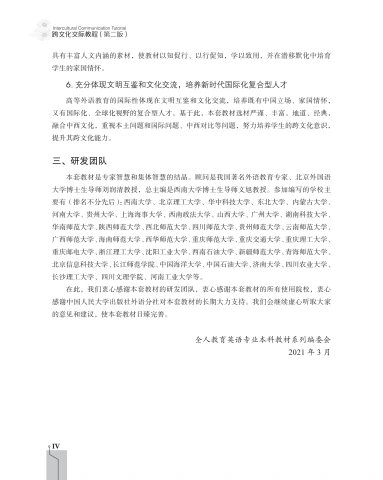
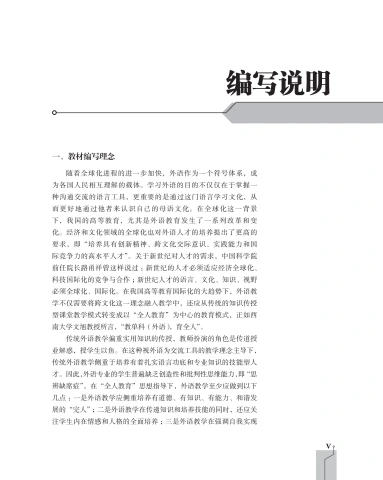
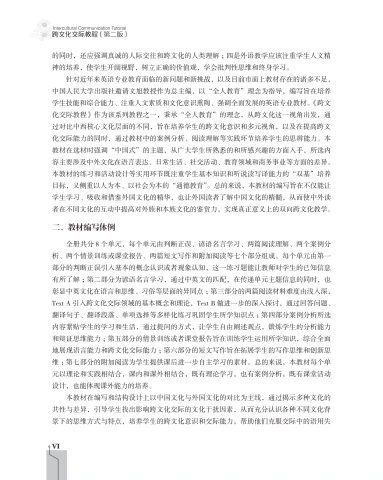


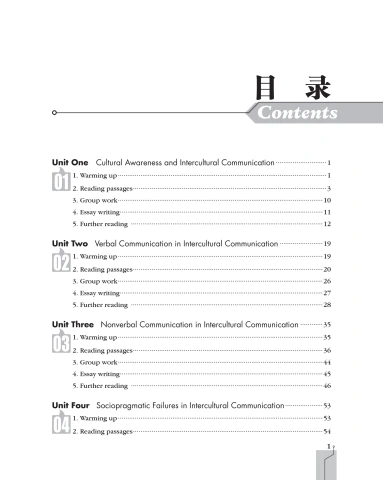
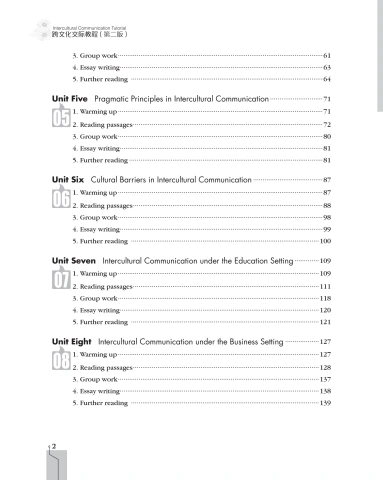
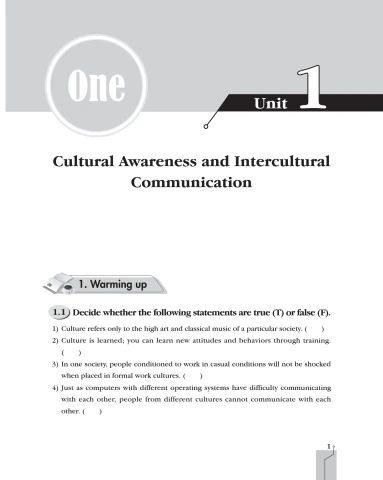
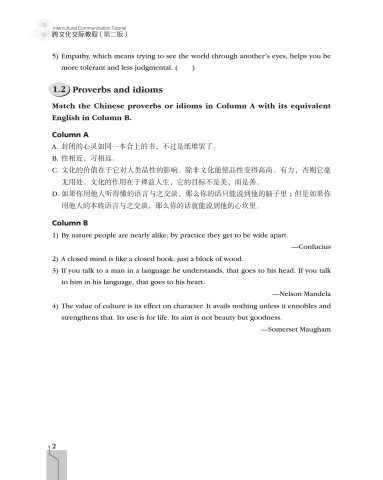
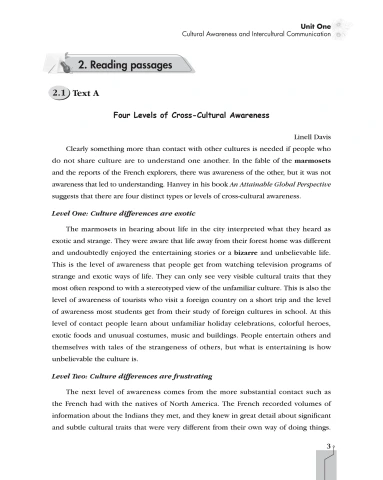


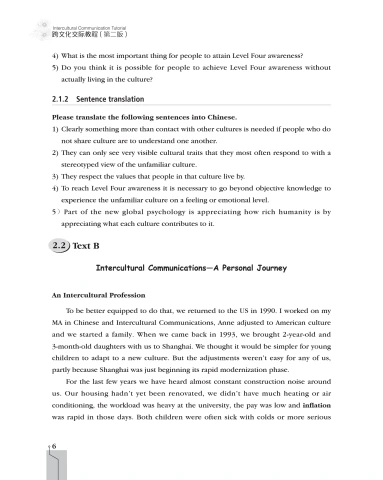

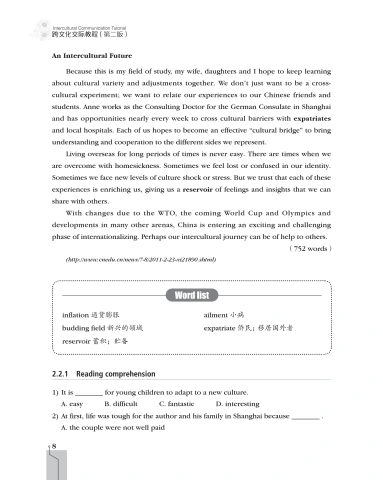
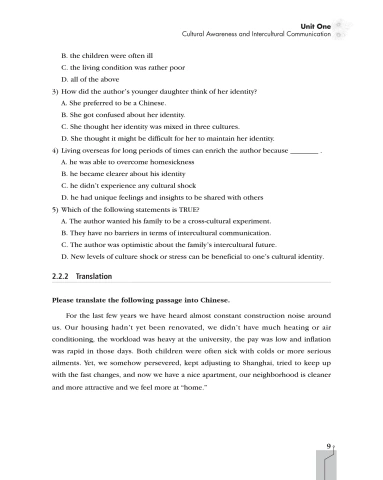
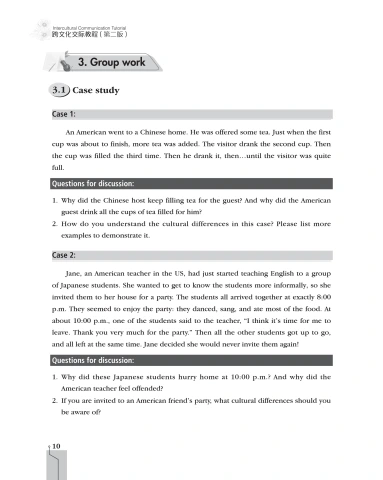
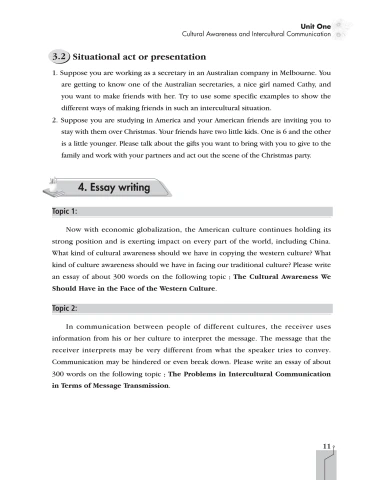
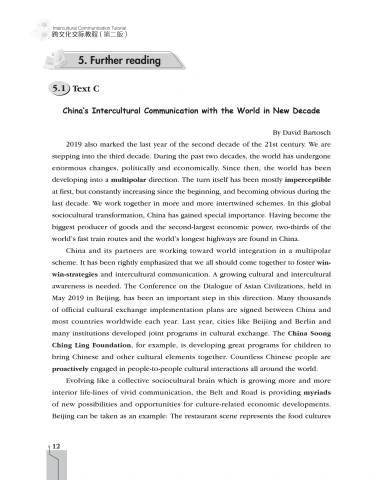
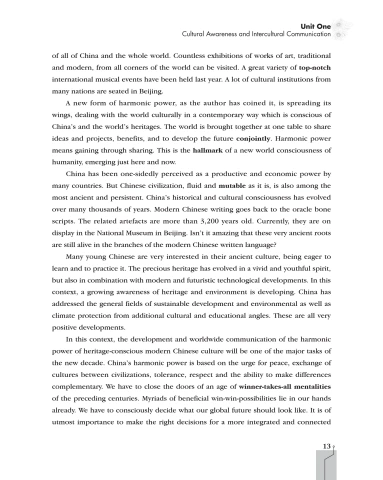
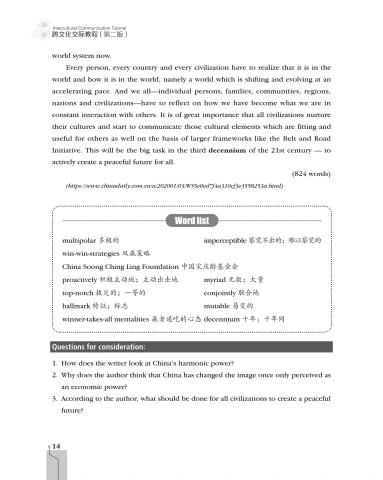
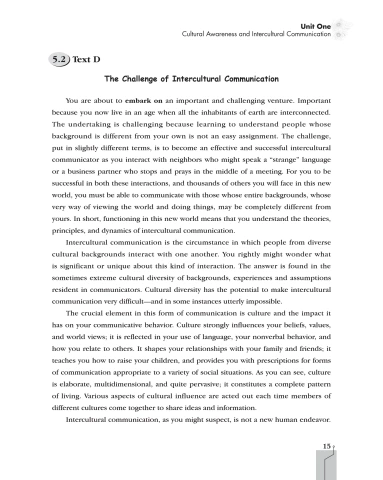
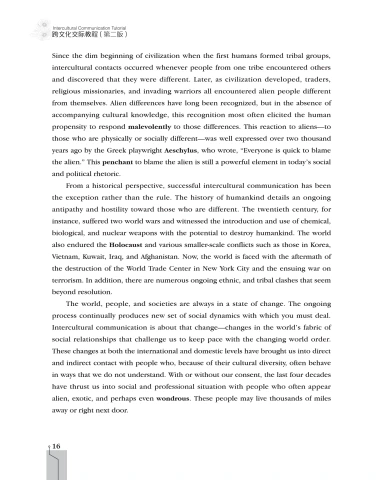


 该页无缩略图
该页无缩略图



